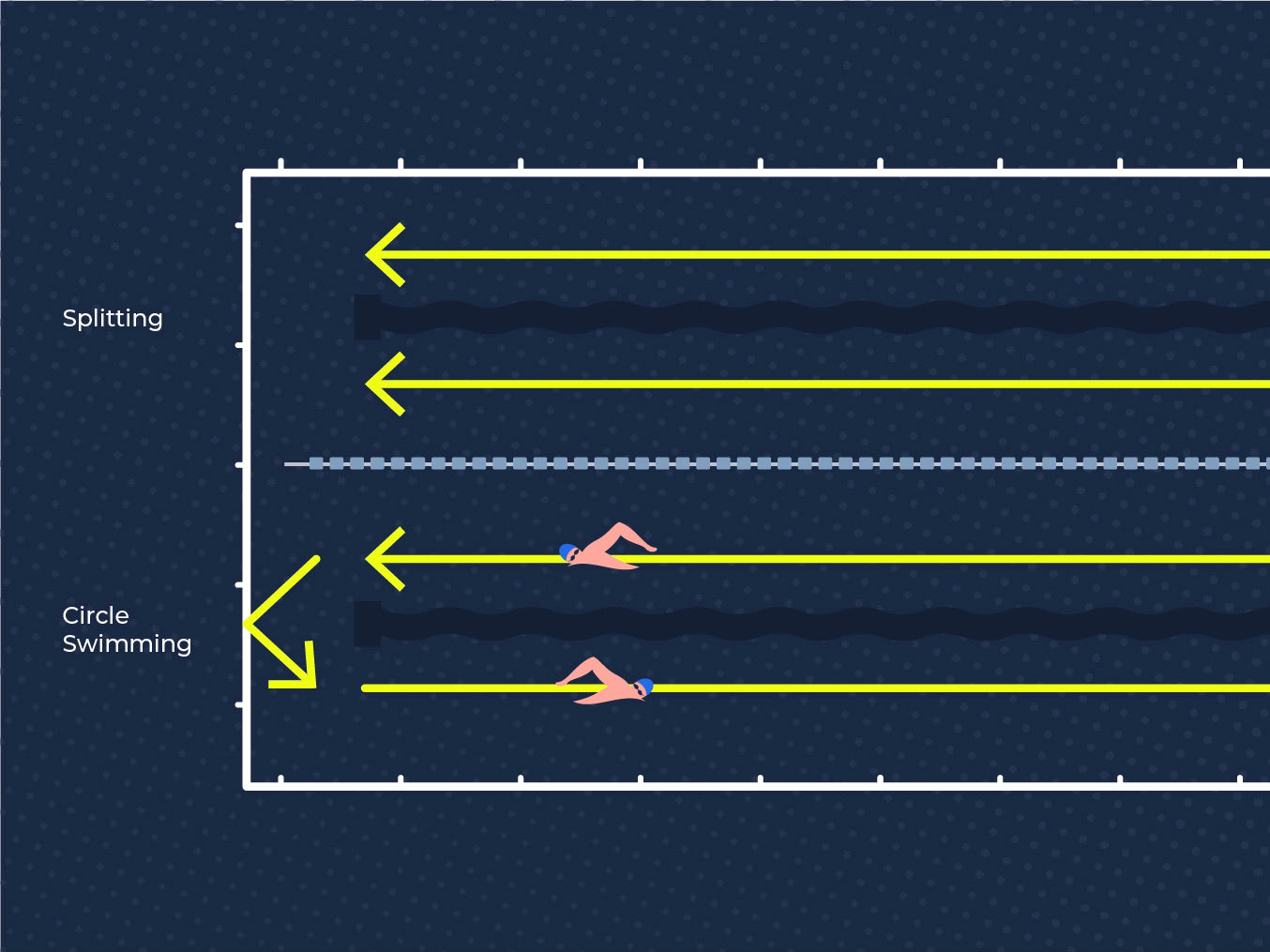Lap Swim Etiquette: Everything You Need to Know
Pool swimming can be a peaceful and meditative experience to glide through the water in rhythm with your body and breath. Plus, a soak in the hot tub afterward doesn’t hurt either.
However, sharing a lane with others can be challenging when you’re all doing something different. We’ve put together a list of 12 swimming etiquette standards to make sure your experience—and the experience of other swimmers—is a pleasant one.

Whether you’re new to lap swimming or you’ve been doing it for years, you’re bound to find some helpful tips below. This article will cover standard lap swimming rules and etiquettes, including choosing the best lane, exiting and entering the pool, sharing the lanes, passing other swimmers, and more.
Lap swim etiquette for all swimmers
1. Choose a lane according to your skill level2. Pick an empty lane first
3. Enter from the ends of the lanes
4. Ask before entering into a lane with someone
5. Check the lane sharing method and lap swim direction
6. Give other swimmers space
7. Don’t push off right before a swimmer turns
8. Turn at the center
9. Tap to pass
10. Never stop in the middle of the lane
11. Rest in the corners
12. Be very careful when wearing hand paddles
1. Choose a lane according to your skill level
Public pools usually have their lanes set up with designated speeds. These range from slower to faster swimmers and often include a lane for those doing physical therapy. Swim in the lane that feels like the best fit for you.
Remember that skill level and speed are subjective—especially at a public swimming pool. Watch other swimmers who are already in the pool to help determine which lane is best for you. You might be swimming in the fast lane one day and in the medium lane the next, depending on who else is in the pool with you.

Don’t overthink the lane speed too much, and be sure to leave your ego in your locker. The speed label is only a guideline; if you find that you’re being passed often by others in your lane, kindly move to the slower lane once you’ve finished your lap at the end of the pool.
2. Pick an empty lane first
If there are multiple lanes available at your decided speed, choose an empty lane. It’s bad lap pool etiquette to crowd a swim lane when it isn’t necessary.
3. Enter from the ends of the lanes
Never enter a swim lane from the side. Always enter feet first from the end of the lanes and never jump into the pool. Entering from the side or the middle of another lane can cause a collision or interrupt other swimmers.
4. Ask before entering a lane with someone
If someone is already swimming in the lane, the best way to signify that you would like to join them is by dangling your feet in the water while sitting on the pool deck. The person swimming laps won’t always stop their workout from talking to you—if they don’t, fully submerge yourself into the lane only after they’ve swum past you and have had the chance to notice your feet.
5. Check the lane sharing method and lap swim direction
Before you start swimming, check the lane sharing method and swim direction! The pool will typically post the preferred lane sharing method. If you’re unsure, ask a facility staff member, a lifeguard, or another swimmer. There are two main lane sharing methods: split lane swimming and circle swimming.

Split lane swimming
Split lane swimming is when only two swimmers share a lane, and each swim exclusively on one side. They do not rotate in a clockwise or counterclockwise direction. Instead, they stick to one side of the lane and go back and forth on that side.
Circle swimming
Circle swimming is where swimmers swim (you guessed it) in a circle—either in a clockwise or counterclockwise direction around the lane. The direction of swimming may vary based on your geographical location. For example, in North America, swimmers will often swim in a counterclockwise circle (on the right side of the lane), and in Australia, swimmers will often swim in a clockwise direction (on the left side of the lane).
6. Give other swimmers space
When sharing a lane, it’s essential to give your fellow swimmers adequate space. When using the split lane approach, stay close to your side of the lane to avoid a head-on collision. When circle swimming, push off when the other swimmer is halfway down the lane. If there are more than two of you in the lane, try to time your push off so you’re halfway between the swimmer ahead of you and the swimmer behind you.

7. Don’t push off right before a swimmer turns
Never push off the wall when another swimmer is approaching the wall to turn. Doing so is very poor lap swim etiquette, as it can easily result in a head-on collision or startle the oncoming swimmer.
8. Turn at the center
This rule only applies to circle swimming. Make sure you turn at the center of the wall, especially when doing a flip turn! Doing this will help avoid head-on collisions and injuries.
9. Tap to pass
If you need to pass the swimmer in front of you, tap them on the foot to let them know. It’s proper pool etiquette for lap swimmers to pass on the inside of the swim lane.
If you feel someone tap on your foot, don’t stop swimming. Simply slow your stride and move closer to the outside of the lane (as much as possible). If your fellow swimmer gives you a tap just before the turn, yield to them at the wall. Move to the far side of the lane line (right side if you’re swimming counterclockwise and left side if you are going clockwise) and let them pass.
10. Never stop in the middle of the lane
Never stop in the middle of the lane and never grab onto the lane lines (also known as the lane dividers). Wait until you get to the wall if you need to adjust your swim cap, suit, or goggles.

11. Rest in the corners
If you get tired during your swim, take a breather at a corner of the wall. Take breaks in the right corner for counterclockwise swims, and for clockwise swims, it is the left corner.
12. Be very careful when wearing hand paddles
Hand paddles are made of hard plastic, so be mindful of your stroke when using them. Trust us; if you accidentally hit someone with paddles on, it won’t feel good for either of you.
What strokes to avoid while lane swimming
Certain strokes require more space than others. For example, butterfly and breaststroke use wide strokes that increase your chances of hitting someone else if you’re sharing a lane. If you choose to swim either of these styles, you’ll need to be very aware of others around you and time your strokes to avoid hitting oncoming swimmers.

Backstroke is another swim style you may want to avoid if someone else is swimming in your lane. In this case, only swim backstroke if you’re a skilled swimmer and are confident you won’t veer into oncoming swimmers.
Want more lap swimming tips?
Sign up for our newsletter to stay updated on all the latest swim trends, techniques, and technological advancements, including for our smart swim goggles. FORM goggles allow you to see your distance, split time, stroke rate, stroke count, distance per stroke, length count, heart rate, and so much more—perfect for lap swimmers who want to improve their fitness and performance.










